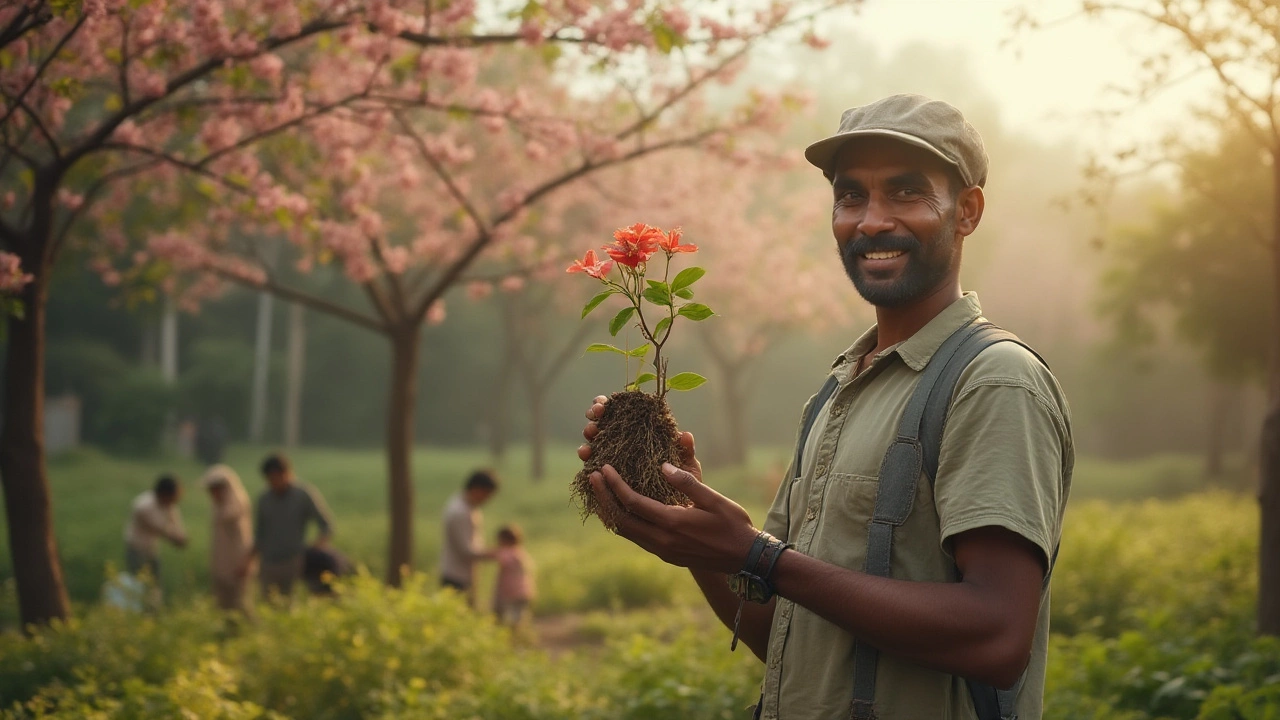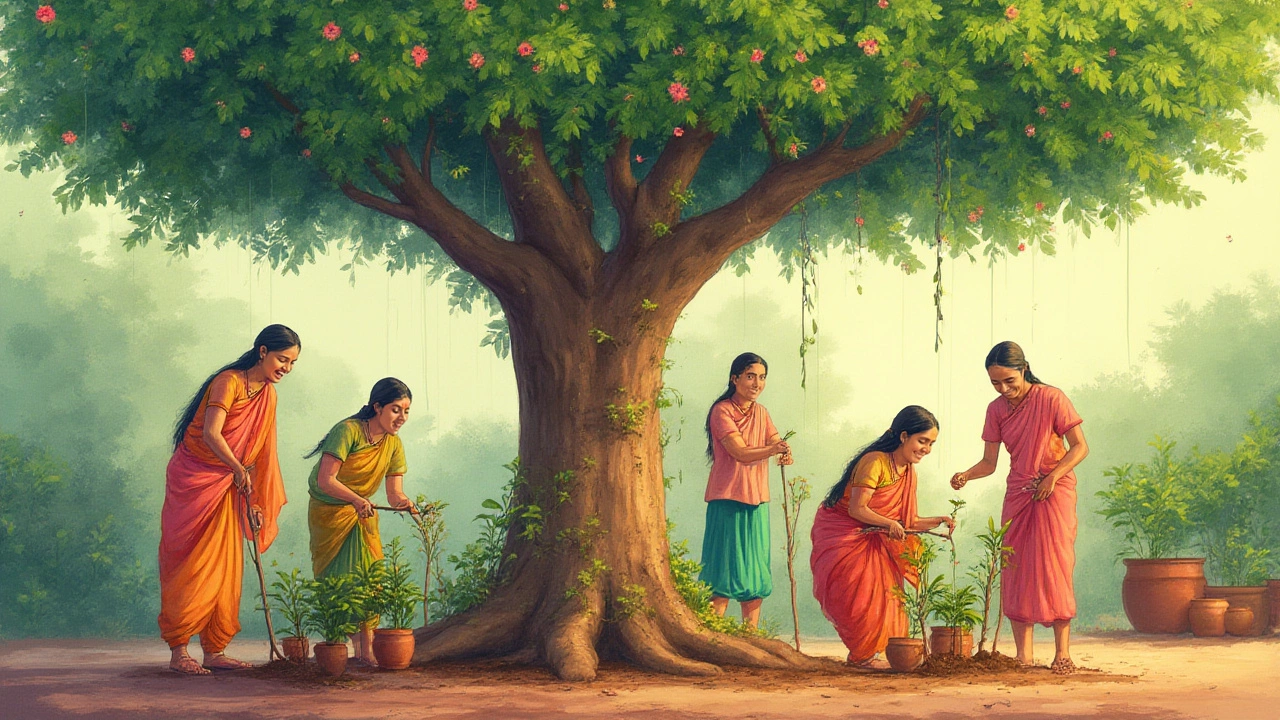Snagging instant bursts of color in your garden can feel impossible if you’re eyeing flower trees. Most folks imagine trees are a decades-long deal, but—surprise—India actually has several flower trees that shoot up fast and start showing off blooms within just a couple of years. Want a lush, flower-packed oasis by the time your WhatsApp group arranges their next meet-up? Here's the lowdown on what really works for Indian soil, climate, and impatient nature-lovers.
Why Some Flower Trees Grow Fast in India
The whole secret is a blend of adaptation and environment. India’s hot, humid, and sometimes monsoon-crazy climate is a dream-come-true for some tree species. Fast growers tend to have wide, shallow root systems and leaves that soak up sunlight like solar panels. Many are native or widely naturalized. That means they're hard-wired to survive the wild swings from hot dry spells to surprise thundershowers.
Soil matters too. Loamy, well-drained soils fuel more rapid root and shoot growth. In cities like Bengaluru and Kolkata, gardeners even give their trees an early head start by adding compost or organic material at planting time. Smart move. These trees' growth isn’t just about trunks and branches; the main reward is those days when you look up and realize your bare patch has exploded into color.
There’s a catch: planting a fast-growing flower tree doesn’t guarantee instant paradise. You’re trading some toughness and lifespan for speed. Expect lighter wood, messier shedding, and the occasional battle against aphids or borers. But for renters, landscapers on a budget, or backyarders itching for that first Instagrammable canopy, it’s the perfect compromise.
Unpacking the Quickest Blooming Flower Trees
So, which flower trees actually make the cut? Ask any nursery owner in Chennai or landscaper in Pune—three names always pop up: Gulmohar, Indian Laburnum, and the good old Kachnar. Let's take a look at what sets these apart.
- Gulmohar (Delonix regia): Sometimes called the 'Flame Tree,' it’s hard to beat for sheer speed. Within 3-5 years, its lacy leaves and fiery, umbrella-shaped crown transform streets and gardens across the subcontinent. Those red-orange flowers arrive with the first real flush of monsoon, attracting honeybees, sunbirds, and most of the neighborhood’s attention.
- Indian Laburnum (Cassia fistula): Better known as ‘Amaltas’ or 'Golden Shower Tree.' This beauty actually doubles as Kerala’s state flower. Its chains of bright yellow blooms drop down like fireworks and are a staple of schoolyards and old British-era parks. It reaches show-off status in only 2-4 years if it gets full sun and some TLC during the dry months.
- Kachnar (Bauhinia variegata): If you want a unique pop of purple or pink, this is it. Not only is it fast—hitting flowering age in 2-3 years—it handles urban pollution surprisingly well and stays compact enough for smaller plots.
Take a look at this data on growth rates under the Indian sun (source: Indian Council of Forestry Research and Education, 2024):
| Tree Species | Time to First Bloom | Average Height in 5 Years (meters) | Hardiness |
|---|---|---|---|
| Gulmohar (Delonix regia) | 3 years | 5-8 m | Moderate (avoids hard frost) |
| Indian Laburnum (Cassia fistula) | 2 years | 4-7 m | High (drought resistant) |
| Kachnar (Bauhinia variegata) | 2 years | 3-6 m | High (tolerates city conditions) |
Runners-up? Try the Neem (Azadirachta indica) for a bit of medicinal value with the pale flowers, or the fragrant Champa (Plumeria) if you love a tropical vibe.

Regional Favorites: Best Fast-Growing Trees by Indian Zones
India isn’t just one climate—it’s a whole buffet. What rockets up on the Deccan plateau might stall in Delhi’s winter. So gardeners play favorites based on where they live.
- South & Coastal India: Gulmohar and Rain Tree (Samanea saman) thrive here. Lots of sun, tons of moisture, and no freezing nights. Perfect for huge, arching canopies in schoolyards and parks.
- North India: Kachnar is king, but don’t write off Jacaranda (Jacaranda mimosifolia). Jacaranda’s crowns of blue are stunning, and it zips up fast in the fertile river plains. Tipuana (Tipuana tipu) also wins hearts for blazing yellow bloom and shadow-casting branches.
- Western India: Amaltas holds up well to dry heat; Bael tree (Aegle marmelos) is another sleeper hit for those wanting something tough and aromatic.
- Northeast & Himalayan Foothills: Even pruned regularly, Cherry Blossom (Prunus cerasoides) leaps up and flashes flower clusters in surprisingly little time.
There’s an old gardening saying floating around Kolkata: Give the right tree the right patch, and it’ll thank you in flowers. Soil pH, rainfall, and even wind matters. If unsure, sneak a look at what’s already thriving in your neighbor's yard. If you see repeated wins, it’s a safe bet it’ll run for you too.
Tips for Maximum Growth: Getting Flower Trees Off the Mark Fast
Just picking the quickest bloomers isn’t quite enough. Here are some sneakily effective real-world tricks straight from Indian horticulturists that can save you years of frustratingly slow progress.
- Plant at the Right Time: Early monsoon is best. The wet soils help even touchy saplings grab hold before the brutal summer returns.
- Prep the Pit: Dig deep, add compost or old cow manure, and sprinkle a mix of garden soil and sand for drainage. Don’t cram it in with existing roots — trees like breathing room.
- Mulch for Speed: Lay down dry leaves or shredded coconut fiber around the tree base. This boosts soil moisture and chokes out pesky weeds that steal nutrients.
- Water the Smart Way: Frequent, deep watering—especially for the first two years—forces roots to reach downward, making trees sturdier and faster to establish.
- Prune Gently: Avoid hacking branches in the first two seasons. A light tip-prune spurs new shoots, but overdoing it can stall growth for months.
- Kick-Start with Mycorrhiza: Many top nurseries in India now sell biofertilizers or root-boosters, loaded with helpful fungi. Real studies show these boost survival rates by up to 30% and cut time to flowering by half a year for species like Cassia and Bauhinia.
If your area faces water shortages, stick to drought-tough options like Amaltas or Neem. Where termites prowl, wrap trunks with a cotton cloth soaked in neem oil until the bark toughens up. And don’t bother with chemical fertilizers in year one—organic works miracles without “burning” young roots.

Pros, Cons, and Long-Term Care of Rapid Bloomers
Planting a fast-growing flower tree sounds perfect, but there are trade-offs. The wood tends to be softer and more breakable during storms. Gulmohar, for example, can drop whole branches in a summer squall, so plant well away from rooflines and overhead wires. Some quick-growing species produce more leaf litter, so be prepared for a little extra sweeping in April and May.
On the bright side, quick trees make it easier to “audition” different looks in a new landscape. If you’re in a rental or want to impress guests fast, it's unbeatable. And because these trees create shade quickly, they help cool your yard and even reduce air conditioning bills as soon as their canopy settles in. Kids and pets will thank you.
Practical care tips? Stake young trees in windy zones to keep them growing straight, and check them weekly during the first two years for signs of pests like mealybugs or caterpillars. A homemade spray of neem oil mixed with water knocks down most outbreaks. After the tree hits its stride (year three or four), you’ll notice flowering seasons become more regular and branch strength improves naturally.
The beauty of these trees isn’t just their speed or their bright flowers—it’s how well they fit into everyday Indian life. They shade roads, flavor air with fragrance, and make every cramped neighborhood look a little more like paradise with every passing summer. Choose smart, plant with care, and the reward is yours in months—not decades.





